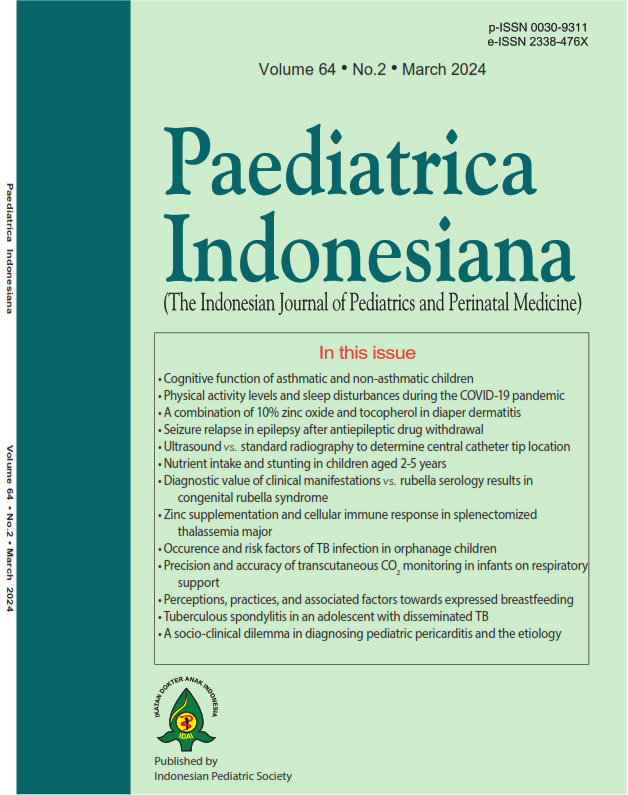Keywords: perception, practice, handling, storage, expressed breast milk
AbstractBackground Expression of breast milk is a strategy to ensures continuous breastfeeding during temporary separation of infant from the mother. Handling and storage of expressed breast milk (EBM) should be based on established recommendations because these practices can affect milk quality and safety.
Objective To describe perceptions and practices of EBM handling and storage, compare with commonly used recommendations and associated factors influencing these practices among mothers in Jakarta, Indonesia,
Methods Mothers who practiced expressed breastfeeding (EBF) to their 6-12 weeks-old infants completed questionnaires about their peceptions and practices on how they handle and storage EBM. The differences in perceptions and practices about expressed breastfeeding management were analyzed using the Chi-square or Fisher's exact test.
Results Among 30 mothers, 14/30 gave EBF exclusively, 19/30 used breast pump, and 26/30 expressed ³6 times/day. Infants in this study received expressed milk 5-10 times per day. Maternal age and resource of information were factors significantly associated with mother’s perceptions, while maternal age, education, and parity were significantly associated with the practices of EBM handling and storage.
Conclusion This study reveals inconsistent perceptions and practices on expressed milk handling and storage by the mothers. They have good knowledge about the theoretical aspects of expressed breastfeeding, but some other techniques are poor, which can be detrimental to the health of the infants. Further study is needed to find more efficient and optimal methods of expressed milk handling and storage, necessitating thoughtful consideration of better practices and recommendations.
References
1. Rosenbaum KA. Exclusive breastmilk pumping: a concept analysis. Nurs Forum. 2022;57:946-53. DOI: https://doi.org/10.1111/nuf.12766
2. Koolaji N, Berry N, Schindeler A, Dehghani F, Banati RB. The risk of infectious pathogens in breast-feeding, donated human milk and breast milk substitutes. Public Health Nutr. 2021;24:1725-40. DOI: https://doi.org/10.1017/S1368980020000555
3. Erika Destianti, Pambudi W. Hubungan pengetahuan ibu menyusui mengenai ASI perah dengan ketepatan manajemen ASI perah. Jurnal Kesehatan dan Kedokteran Tarumanagara. 2022;1:54-62.
4. Layrenshia B, Pambudi W. Karakteristik pendonor air susu ibu (ASI) di media sosial. Tarumanagara Med J. 2022;1:7. DOI: https://doi.org/10.14238/sp24.1.2022.7-15
5. Layrenshia B, Pambudi W. Karakteristik pengguna media daring dalam praktik berbagi air susu ibu. Sari Pediatr. 2022;24:7. DOI: https://doi.org/10.14238/sp24.1.2022.7-15
6. Eglash A, Simon L, Academy of Breastfeed Med. ABM clinical protocol# 8: Human milk storage information for home use for full-term infants, revised 2017. Breastfeed Med. 2017;12:390-5. DOI: https://doi.org/10.1089/bfm.2017.29047.aje
7. CDC. Human Milk Storage Guidelines. Proper storage and preparation of breast milk. [cited 2023 May 31]. Available from: https://www.cdc.gov/breastfeeding/ recommendations/handling_breastmilk.htm
8. Bai DL, Fong DY, Lok KY, Wong JY, Tarrant M. Practices, predictors and consequences of expressed breast-milk feeding in healthy full-term infants. Public Health Nutr. 2017;20:492-503. DOI: https://doi.org/10.1017/S136898001600241X
9. Rasmussen KM, Felice JP, O'Sullivan EJ, Garner CD, Geraghty SR. The meaning of “breastfeeding” is changing and so must our language about it. Breastfeed Med. 2017;12:510-4. DOI: https://doi.org/10.1089/bfm.2017.0073
10. Wu W, Zhang J, Silva Zolezzi I, Fries LR, Zhao A. Factors influencing breastfeeding practices in China: A meta?aggregation of qualitative studies. Maternal & Child Nutr. 2021;17:e13251. DOI: https://doi.org/10.1111/mcn.13251
11. Dietrich Leurer M, McCabe J, Bigalky J, Mackey A, Laczko D, Deobald V. “We just kind of had to figure it out”: a qualitative exploration of the information needs of mothers who express human milk. J Hum Lact. 2020;36:273-82. DOI: https://doi.org/ 10.1177/0890334419883203
12. Yamada R, Rasmussen KM, Felice JP. “What is ‘enough,’and how do i make it?”: a qualitative examination of questions mothers ask on social media about pumping and providing an adequate amount of milk for their infants. Breastfeed Med. 2019;14:17-21. DOI: https://doi.org/10.1089/bfm.2018.0154
13. Bass JL, Gartley T, Kleinman R. World Health Organization baby-friendly hospital initiative guideline and 2018 implementation guidance. JAMA Ped. 2019;173:93-4. DOI: https://doi.org/10.1001/jamapediatrics.2018.3808
14. Porta R, Miralles N, Paltrinieri A, Ibáñez B, Giménez J, Roca T, et al. A breast milk pump at the bedside: a project to increase milk production in mothers of very low birth weight infants. Breastfeed Med. 2021 Apr 1;16(4):309-12. DOI: https://doi.org/10.1089/bfm.2020.0122

How to Cite
1.
Pambudi W, Dewanto NE, Yusra Y, Werdhani R, Endaryanto A, Fahmida U, Alatas F, Hegar B. Perceptions, practices, and associated factors towards expressed breastfeeding among mothers in Jakarta, Indonesia. PI [Internet]. 23Apr.2024 [cited 4Jun.2024];64(2):168-5. Available from: https://www.paediatricaindonesiana.org/index.php/paediatrica-indonesiana/article/view/3585
Section
Pediatric Nutrition & Metabolic Disease
Copyright (c) 2024 Wiyarni Pambudi, Naomi Esthernita Fauzia Dewanto, Yusra Yusra, Retno Asti Werdhani, Anang Endaryanto, Umi Fahmida, Fatima Safira Alatas, Badriul Hegar Syarif

This work is licensed under a Creative Commons Attribution-NonCommercial-ShareAlike 4.0 International License.
Authors who publish with this journal agree to the following terms:
Authors retain copyright and grant the journal right of first publication with the work simultaneously licensed under a Creative Commons Attribution License that allows others to share the work with an acknowledgement of the work's authorship and initial publication in this journal.
Authors are able to enter into separate, additional contractual arrangements for the non-exclusive distribution of the journal's published version of the work (e.g., post it to an institutional repository or publish it in a book), with an acknowledgement of its initial publication in this journal.

This work is licensed under a Creative Commons Attribution-NonCommercial-ShareAlike 4.0 International License.
Received 2023-09-20
Accepted 2023-09-26
Published 2024-04-23
Comments (0)